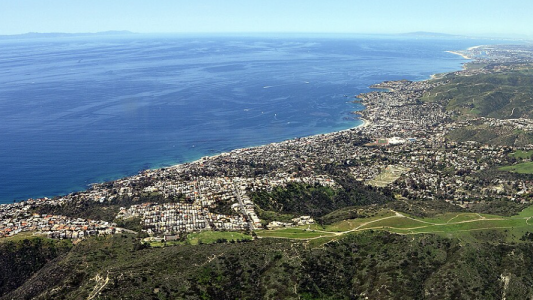Who really owns the coast? One state cracks down on beach access violations by luxury resorts
- Replies 0
California’s sun-kissed coastline is a national treasure—a place where the Pacific’s waves meet golden sands, and where every American, from surfers to sandcastle architects, is promised a front-row seat to nature’s splendor.
But what happens when a luxury hotel decides to roll out the velvet rope and keep the public at bay?
That’s the million-dollar (or, more accurately, $11,000-a-day) question facing the iconic Hotel Laguna in Laguna Beach.
A Beachfront Battle: Public Access vs. Private Profits
Hotel Laguna, a storied establishment perched on the edge of Orange County’s legendary shoreline, is in hot water with the California Coastal Commission (CCC).
The hotel stands accused of erecting sand berms—think man-made dunes—and posting warning signs to carve out a private oasis for its guests.
The catch? This stretch of sand is public land, protected by the 1976 Coastal Act, which was designed to ensure that all Californians (and visitors from across the country) can enjoy the state’s 1,000-mile coastline.
The CCC’s May 8 letter to Hotel Laguna was clear: remove the barricades and signage or face a daily fine of $11,250.

The hotel was given until May 23 to provide photographic proof that the beach had been returned to the people. If not, the fines would start stacking up faster than beach towels on a summer Saturday.
A Pattern of Pushback
This isn’t Hotel Laguna’s first run-in with the law over beach access. According to the CCC, the hotel has been warned three times before about similar violations.
Each time, the hotel’s owner, Michael Kluchin, and his legal counsel, Sherman Stacey, promised to play by the rules.
Yet, the latest inspection found that the hotel’s current signage and sand berms “do not resemble or have the intended effect” of the examples provided by the Commission.
Also read: This genius trick gets you a free breakfast, but it’s causing outrage—are you brave enough to try it?
To make matters worse, the hotel never filed the required Coastal Development Permit (CDP) for these new barriers.
In the eyes of the CCC, that’s a big no-no. The Commission’s mission is to “provide maximum public access to the coast,” and any attempt to privatize public land—especially without permission—strikes at the heart of California’s coastal values.
Why This Matters: The Bigger Picture
You might be wondering, “Why all the fuss over a few signs and a pile of sand?”
The answer goes beyond Laguna Beach. California’s coastline is a public trust, and the Coastal Act is one of the strongest protections of its kind in the country.
Source: @hotellaguna / Instagram.
It was born out of a hard-fought battle to keep beaches open to everyone, not just the wealthy or well-connected.
When a hotel—or any private entity—tries to claim a slice of the shore, it sets a dangerous precedent. If left unchecked, it could mean fewer places for families to picnic, fewer waves for surfers to ride, and fewer sunsets for all of us to enjoy.
The CCC’s tough stance sends a message: California’s beaches belong to the people, not just a few.
As of this writing, Hotel Laguna hasn’t responded to requests for comment. On its website, the hotel proudly claims to be the first hotel in over 125 years to grace this famous stretch of sand. It’s a legacy property, woven into the fabric of Laguna Beach.
Also read: Think you can swim safely? National Hurricane Center to roll out new rip current risk map
But with great history comes great responsibility—and, apparently, a hefty fine if you cross the line.
A National Conversation: Who Owns the Shoreline?
This isn’t just a California issue. Across the country, from the Hamptons to the Gulf Coast, battles over beach access are heating up.
Private landowners and luxury resorts often try to limit public entry, citing everything from “safety concerns” to “guest experience.”
But the public trust doctrine—a legal principle dating back centuries—says that certain resources, like the seashore, are held in trust for everyone.
In recent years, grassroots groups and coastal advocates have fought to reclaim access, sometimes winning landmark victories. The Hotel Laguna case is just the latest chapter in this ongoing saga.
Read next: A flight attendant reveals insider tips—Are you making these common mistakes?

Have you visited Laguna Beach or stayed at Hotel Laguna? Have you ever been turned away from a public beach by a sign or a fence? Do you think luxury hotels should be able to reserve parts of the shoreline for their guests, or should the coast remain open to all?
We want to hear your thoughts, memories, and opinions. Drop a comment below and let’s keep the conversation going!
But what happens when a luxury hotel decides to roll out the velvet rope and keep the public at bay?
That’s the million-dollar (or, more accurately, $11,000-a-day) question facing the iconic Hotel Laguna in Laguna Beach.
A Beachfront Battle: Public Access vs. Private Profits
Hotel Laguna, a storied establishment perched on the edge of Orange County’s legendary shoreline, is in hot water with the California Coastal Commission (CCC).
The hotel stands accused of erecting sand berms—think man-made dunes—and posting warning signs to carve out a private oasis for its guests.
The catch? This stretch of sand is public land, protected by the 1976 Coastal Act, which was designed to ensure that all Californians (and visitors from across the country) can enjoy the state’s 1,000-mile coastline.
The CCC’s May 8 letter to Hotel Laguna was clear: remove the barricades and signage or face a daily fine of $11,250.

Hotel Laguna in California has been accused of blocking public access to the beach by erecting sand berms and putting up signs, all without the proper coastal development permit. Image source: D. Ramey Logan / Wikimedia Commons.
The hotel was given until May 23 to provide photographic proof that the beach had been returned to the people. If not, the fines would start stacking up faster than beach towels on a summer Saturday.
A Pattern of Pushback
This isn’t Hotel Laguna’s first run-in with the law over beach access. According to the CCC, the hotel has been warned three times before about similar violations.
Each time, the hotel’s owner, Michael Kluchin, and his legal counsel, Sherman Stacey, promised to play by the rules.
Yet, the latest inspection found that the hotel’s current signage and sand berms “do not resemble or have the intended effect” of the examples provided by the Commission.
Also read: This genius trick gets you a free breakfast, but it’s causing outrage—are you brave enough to try it?
To make matters worse, the hotel never filed the required Coastal Development Permit (CDP) for these new barriers.
In the eyes of the CCC, that’s a big no-no. The Commission’s mission is to “provide maximum public access to the coast,” and any attempt to privatize public land—especially without permission—strikes at the heart of California’s coastal values.
Why This Matters: The Bigger Picture
You might be wondering, “Why all the fuss over a few signs and a pile of sand?”
The answer goes beyond Laguna Beach. California’s coastline is a public trust, and the Coastal Act is one of the strongest protections of its kind in the country.
Source: @hotellaguna / Instagram.
It was born out of a hard-fought battle to keep beaches open to everyone, not just the wealthy or well-connected.
When a hotel—or any private entity—tries to claim a slice of the shore, it sets a dangerous precedent. If left unchecked, it could mean fewer places for families to picnic, fewer waves for surfers to ride, and fewer sunsets for all of us to enjoy.
The CCC’s tough stance sends a message: California’s beaches belong to the people, not just a few.
As of this writing, Hotel Laguna hasn’t responded to requests for comment. On its website, the hotel proudly claims to be the first hotel in over 125 years to grace this famous stretch of sand. It’s a legacy property, woven into the fabric of Laguna Beach.
Also read: Think you can swim safely? National Hurricane Center to roll out new rip current risk map
But with great history comes great responsibility—and, apparently, a hefty fine if you cross the line.
A National Conversation: Who Owns the Shoreline?
This isn’t just a California issue. Across the country, from the Hamptons to the Gulf Coast, battles over beach access are heating up.
Private landowners and luxury resorts often try to limit public entry, citing everything from “safety concerns” to “guest experience.”
But the public trust doctrine—a legal principle dating back centuries—says that certain resources, like the seashore, are held in trust for everyone.
In recent years, grassroots groups and coastal advocates have fought to reclaim access, sometimes winning landmark victories. The Hotel Laguna case is just the latest chapter in this ongoing saga.
Read next: A flight attendant reveals insider tips—Are you making these common mistakes?
Key Takeaways
- Hotel Laguna in California has been accused of blocking public access to the beach by erecting sand berms and putting up signs, all without the proper coastal development permit.
- The California Coastal Commission has given the hotel until 23 May to remove these unauthorized barricades and signage, or face a hefty fine of $11,250 each day.
- This isn’t the first time Hotel Laguna has allegedly breached property laws, with the commission claiming previous warnings have gone ignored despite multiple communications and agreements with the hotel’s management.
- The Commission says the unauthorized barriers are stopping the public from properly accessing the coastline, which goes against state law aimed at protecting and providing maximum access to California's beaches.
Have you visited Laguna Beach or stayed at Hotel Laguna? Have you ever been turned away from a public beach by a sign or a fence? Do you think luxury hotels should be able to reserve parts of the shoreline for their guests, or should the coast remain open to all?
We want to hear your thoughts, memories, and opinions. Drop a comment below and let’s keep the conversation going!






